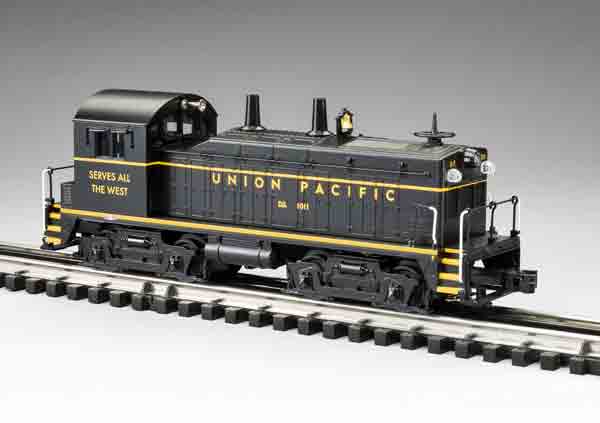Price: $449.95 (no. 21652) Min Curve: O-27 Cmd Low: N/A Cnv Low: 19 smph High: 38 smph Drawbar pull: 1 lb.
Features: Two can-style motors, dual headlights, die-cast metal trucks and couplers, TrueBlast Plus sound
Current production road names: Boston & Maine, Pennsylvania RR, Union Pacific, Western Pacific
The diesel switcher offered a reduction in operational costs for water and coal and disposal of ash, along with, a maintenance team requiring skills from plumbers to metal workers. And its startup didn’t require setting a fire – nothing more than pressing a button.
General Motors built more than 1,100 of its 1,000-horsepower NW2 diesel locomotives between 1939 and1949. This window included handling the impossible tonnages of Second World War freight traffic. Accordingly, the NW2 was one of the victors by way of wartime efficiency.
At least 22 examples of the venerable switcher have survived, and they live in a mixture of museum and shortline railroad operations.
Opening the box
The lineage of the Williams NW2 clearly derives from the postwar Lionel NW2 of fond memory. That O gauge model was a good replica of the prototype.
The pilots are die-cast metal and have plenty of space for the coupler to swing (pretty important when operating on O-27 curved track). There are brakeman’s steps and cast-in grab irons on the frame.
There are wire add-on grab irons and handrails on the deck, and the deck has safety tread. The battery boxes in front of the cab have cast-in latches and cast-in louvers on the sides. There are two handrails that run up to the cab door.
The cab has four windows on the long-hood side, and six on the deck side. There are two-pane windows on both sides of the cab. I’ve always liked how the model has “folded up” sunscreens cast into the side of the cab. You’ll find a headlight over the cab door and a cast-in grab iron just to the right. A simulated horn is mounted on the opposite side of the cab, centered above the windows.
The long hood has ample cast-in detailing for the door, latches, and hinges.
There are add-on handrails running the length of the hood and secured by stanchions. The top of the roof has cast-in access hatches, rivet detailing, and intakes. There are two smokestacks, a bell, and a radio antenna.
The long-hood nose has cast-in detailing for a radiator air intake. A headlight is mounted in the center, between non-functional marker/classification.
Painting and decoration are worth a few comments. I was surprised to see a Union Pacific diesel in black paint. Sure enough, in the earlier days of dieselization, the Union Pacific painted some switchers in black before settling on yellow for a locomotive livery.
The shade of black on the model is the sort of hue that if I look at it in one setting, the light tells my eyes it is black. A different light source and my eyes conclude it is navy blue. It is black, but seemed close to a Baltimore & Ohio blue.
Paint was cleanly and evenly applied throughout the model. The steps were painted yellow, and the yellow pinstriping on the body was first rate. Application of “Serves all the West,” the road name, and unit numbers were clean and crisp. You will also find an EMD builder’s plate on the side of the cab. Not an elaborate livery, but one that’s well executed.
On the test track
First and foremost, you need to recall that this model is a conventional locomotive and so doesn’t operate in Lionel TrainMaster or Legacy modes or with MTH’s Digital Command System. This is a good old hand-on-the-throttle model sure to play well with your older O gauge trains!
There is no external volume control, although you can lock the locomotive in one direction. Check beneath the frame on the long-hood end.
The locomotive sounds started up quickly and could be easily heard. This was a good sound package that satisfied my expectation for a simple system.
Throttle and motor response was good, and it ran quietly. What could be most heard trackside were diesel sounds and track clickety-clack.
Our low-speed average was 19 scale miles per hour. Tack on some rolling stock, and the start will be a bit slower. The high-speed average was 78 scale miles per hour. The NW2 tackled everything we put behind it. Drawbar pull was 1 pound.
The Williams by Bachmann NW2 is a nice-looking model of a perennial of American railroading. The operational characteristics of this conventional-only locomotive were fine, and the sound system was a good addition. This model would be a good choice for a single locomotive holiday layout, or as part of a larger fleet.














